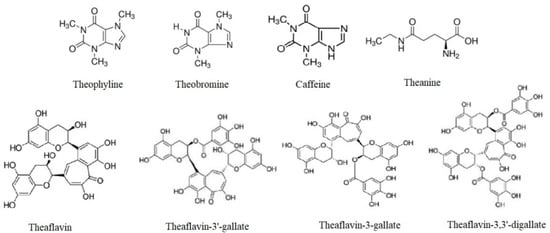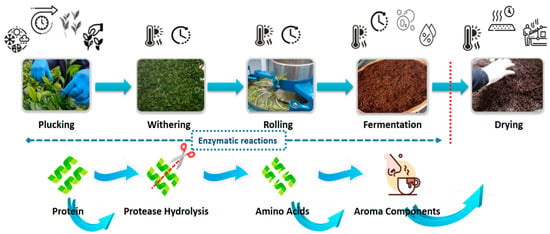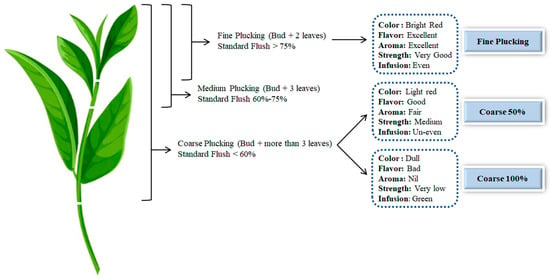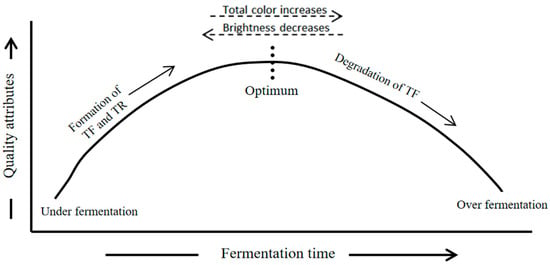Tea (Camellia sinensis) has grown for over 300 years and is recognized worldwide as among other well-renowned crops. The quality of black tea depends on plucking (method, standard, season, and intervals), withering and rolling (time and temperature), fermentation (time, temperature, and RH), drying (temperature and method), and storage conditions, which have a high influence on the final quality of black tea. At the rolling stage, the oxidation process is initiated and ends at the early drying stage until the enzymes that transform tea polyphenols into thearubigins (TRs) and theaflavins (TFs) are denatured by heat. By increasing fermentation time, TRs increased, and TF decreased. Each is liable for black tea’s brightness, taste, and color.
- black tea
- processing technique
- phytochemical profile
1. Introduction
2. Black Tea’s Health Benefits and Chemical Composition
Tea is abundant in amino acids, caffeine, polyphenols, and other functional elements that have been connected to a variety of health benefits, including anti-inflammation, antioxidation, anti-mutagenic, anti-cancer, and enhancement of psychomotor performance [15][16][17][18][24,25,26,27]. Any changes in the aforementioned composition of phytochemicals affect the quality of black tea [19][28]. To determine tea consumption’s potential in avoiding different oxidative-stress-related chronic diseases like diabetes, Alzheimer’s disease, cardiovascular conditions, and some cancers, numerous in vitro, in vivo human, and animal intervention studies have been conducted [20][21][29,30]. Tea phytochemicals, notably polyphenols, are primarily responsible for these protective effects [22][31]. Among the many chemical substances in tea shoots, the high concentrations of polyphenols and caffeine are particularly notable. Proteins, carbohydrates, amino acids, lipids, caffeine, polyphenols, fiber, and minerals are the primary chemical components of the green leaf [23][39]. Tea leaves contain chemical constituents, including methylxanthines, vitamins, and more than 600 volatile compounds. It comprises 25 to 35% polyphenols by dry weight [24][8]. The most significant antioxidants, catechins, make up 25% of their dry weight [9][25][26][12,40,41]. Besides theanine, fresh tea leaves include methylxanthines (theophylline, caffeine, and theobromine) [20][27][29,42], and the main TFs include theaflavin, 3-gallate, 3′-gallate, and 3,3′-gallate (Figure 12) [28][43].
3. Black Tea’s Manufacturing Cycle and Its Influence on Quality Characteristics

3.1. Plucking/Harvesting/Picking
3.1.1. Plucking Method
3.1. Plucking/Harvesting/Picking
3.1.1. Plucking Method
3.1.2. Plucking Standard
Plucking standards are essential factors in determining black tea’s quality. The standard of plucking has a significant impact on tea quality and yield. Many high-quality teas require uniform and tender leaves. Plucking standards are often classified as fine, medium, or coarse, with the given percentages of 75%, 60–70%, or less than 60%, respectively (
3.1.3. Shooting Period/Plucking Interval
3.1.3. Shooting Period/Plucking Interval
3.1.4. Plucking Season
The seasonal changes in temperature and weather, humidity, rainfall, and soil water deficiencies affect annual yield as well as annual yield distribution [47][48][74,75] and also black tea’s quality [49][76]. The performance of most crops, including tea, varies from season to season and from locality to locality [50][77]. These variances result from a difference in growth parameters [51][78], which causes a change in the overall quality and chemical composition of black tea [52][79]. Tea quality depends upon seasonal variations in terms of moisture content, TFs, and TRs, which also link well with tea color [53][80]. TFs and TRs, two significant polyphenols used as black tea quality indicators, make up 50–70% of the phenolic components in tea water extract [54][81]. Black tea’s quality is mostly determined by the phenolic chemicals that are found in young tea shoots [55][82]. Low-quality black teas have a low total polyphenol concentration [56][83]. It has been examined previously how harvesting seasons affected the physicochemical properties of “Yinghong 9” (Yh) and its mutant “Huangyu” (Hy) black tea with large leaves. The results showed spring through summer-processed black tea showed significant soluble sugar and caffeine increases, while free amino acids decreased significantly. This variation was noticed in both Yh and Hy [57][85], and the outcomes follow previous findings [58][86], which defend it from UV radiation across the three harvesting seasons [59][87]. Tea is cultivated from the equator to the subtropics, where seasonal changes may be extreme [47][60][74,90]. Seasonal temperatures in the Kericho District, Kenya, range from 15 to 17 °C compared to the Tea Research Foundation of Central Africa at 18–24 °C [61][91]. Early research in Central Africa found that fresh apical shoots have the highest level of flavanols in the winter season. Tea shoots harvested under conditions of slow growth, such as during the cool season, exhibited higher levels of simple catechins compared to catechin gallates, and the most significantly affected compound is epigallocatechin gallate (EGC). Contrarily, total flavanol concentration is highest during the summer (growing season) and lowest in late autumn in the northern hemisphere. Cool, slow-growing seasons result in black teas with high quality but low production [62][92]. Dry or severely cold seasons reduce yields [63][93], which is in accordance with a previous study [64][94] that declared that slow shoot growth in dry and cool seasons increases black tea quality, while fast tea flush growth in wet seasons, especially rainy periods, lowers black tea’s quality. If the soil is moist, high temperatures promote rapid shoot growth, increasing production but reducing black tea quality.4. Withering Stage
Withering, as the initial step in manufacturing black tea, is crucial to produce high-quality black tea. Tea processing begins with withering, where freshly harvested tea leaves are spread out in a proper withering system to lose moisture before processing [32][49]. For the subsequent steps, tea leaves go through a series of physical and chemical changes [31][65][47,98]. In tea processing, leaf moisture is crucial; tea leaf withering partially dries the surface and core moisture of tea leaves [66][99]. Black tea leaves are usually withered at room temperature to reduce moisture. Tea shoots undergo withering from being harvested until they are macerated or rolled [31][47]. Turgid tea shoots become flaccid as moisture levels decrease on a wet basis from ~70–80% to 60–70% during the withering process [67][100]. Chemical and physical withering are the two main kinds of withering. During the procedure, tea shoots experience chemical and physical changes [31][47]. Immediately after harvesting tea leaves, chemical withering occurs. This process breaks down complex chemical compounds into volatile flavor compounds, simple sugar, and amino acids. The enzymatic activities and caffeine content rise with withering. Additionally, it has been found that during the process of withering, lipids degrade into simpler molecules, and the catechin amount drops [67][100]. The withering phase’s dehydration shock induces enzymatic ripening and gives the shoots a floral flavor. On the other hand, physical withering is the process of moisture removal from tea leaves and changing tea leaves’ cell membrane permeability. Both methods of withering are essential, and it is difficult to achieve ideal attributes (color, flavor, aroma, and taste) from uneven or un-withered leaves. Another major determinant of tea quality is withering temperature. Excessive heat during withering destroyed the leaf cell matrix, resulting in earlier uncontrolled fermentation-like responses [40][60]. It has been evaluated how temperature and moisture loss affect TFs, TRs, and volatile flavor components development during withering. Results show that restricting moisture loss during the early withering stage improves black tea quality. Some unfavorable enzymatic reactions occur at high temperatures, leading to an undesirable amount of TFs and TRs, which results in an increase or decrease in the flavor index, brightness, and black tea’s sensory quality. The two primary kinds of VFC are E-2-hexenal and hexanal (Group I) and geraniol and linalool (Group II). Group II volatile flavor compounds contribute to a good effect on aroma, and Group I volatile flavor compounds grant inferior aroma [56][83]. Withering decreases the total amount of Group I volatile flavor compounds while increasing the total of Group II volatile flavors [68][69][107,108]. The Group II VFC was raised when tea shoots were restricted in their moisture loss for a prolonged period prior to physical wither, which improves the aroma’s overall quality. However, stressed shoots have the most Group I volatile component. The flavor index needs to be optimal to improve quality. It has also been concluded that a low temperature of 22 °C increased TF, total color, and brightness [70][105]. The over-withered tea shoots harden and blunt the roller or maceration machine. As a result, tea fiber content rises, as do the possibilities of over-firing and over-fermentation. In contrast, a high content of moisture in withered leaves leads to clog crush, tea, and curl (CTC) and the Rotorvane machine during operation [71][109]. It has been examined how withering affects fermentation [72][110]. During fermentation, (PPO) polyphenol oxidase activity affects TF and TR production. TFs and TRs give tea liquors briskness, brightness, and “body”. It has also been found that more extreme withering and greater moisture loss decrease PPO activity. Therefore, black tea loses briskness and brightness. Tea leaves, which are shortly withered, result in more briskness and brightness due to a rise in TF formation. Extreme moisture loss, such as long duration or high temperature, reduces green leaf PPO activity during withering [26][41]. It has been reported optimum withering time is 14 h [72][110]. It has been shown that the duration of withering has a direct effect on volatile compounds content. The leaves following hard withering have more hexenal, linalool, and oxides, which explains why such tea fragrances more [73][116]. Withering temperature affects the brightness of black tea, and withering at low temperatures can result in brighter tea [70][105]. Allowing withering for 8 ± 0.5 h to 10 ± 0.5 h can enhance quality and nutritional value. It reveals that withering time duration is essential for biochemical properties. This stage can be controlled and monitored to produce high-quality black tea [29][45]. Good-quality black tea requires optimized chemical withering. There is no set standard for withering. It varies with leaf quality, requirements, and ambient conditions. For maceration, withered leaves should have 68–72% moisture is recommended. Tea shoots to wither properly depends on plucking, transportation, time, temperature, and environmental conditions. Thus, withering must be regulated to ensure high-quality tea [67][100].5. Rolling/Maceration Stage
Post-withering tea leaves are macerated or rolled to rupture plant cell structures, allowing catechins, polyphenol oxidase, and peroxidase to interact during fermentation [74][97]. Rolling extracts and twists leaf juice [36][54]. The main goal of rolling is size reduction and cell destruction to expose new surfaces to air during fermentation. It also presses out juice and coats leaf particles with a thin juice coating to accelerate chemical reactions [75][119]. This process is crucial for black tea production since most TFs are generated during rolling [76][112]. During rolling, enzymes are released from the leaf when it is broken and exposed to oxidation. Crush particles (dholes) were crushed by the rotor vane machine after rolling. After crushing, the material was run through a CTC crush tear and curl machine to make particles finer. The material then experiences a roll breaker, which breaks the twisted balls and reduces fermentation [40][60]. In Sri Lankan black tea production, orthodox rolling is used to gently roll tea leaves. The rolling method produces black orthodox tea. For tea leaf pulverization in Central Africa, a Lawrie tea processor is used, which can also be used to treat them harsher [77][120], whereas Indian and Kenyan tea leaves are crushed and macerated using crush tear and curl machines [77][78][120,121], which are referred to as black crush tear and curled teas. The maceration methods that influence black tea’s chemical composition and quality were investigated by [79][113]. While rolling tea shoots, polyphenol oxidase oxidizes catechins and leads to the formation of TFs and TRs. TFs provide tea liquor’s brightness and briskness, while thearubigins contribute to taste and orange-brown color [80][122]. With an exhaust temperature below 49 °C for a long time, the post-fermentation process will soften the liquor. Exhaust temperatures above 57.2 °C accelerate moisture removal, resulting in hardened tea with hard particles but incomplete drying. Such types of tea do not store well and have harsh liquors [75][119]. Catechins and gallates oxidize to TFs and TRs. Black tea’s TFs and TRs not only rely on the green leaf’s oxidase activity, the content of flavanol and protein but also the processing method and leaf resistance to mechanical damage. This resistance affects CTC processing less than orthodox. Crush, tear, and curl and orthodox teas differ greatly in TF and TR content. TFs and TRs are higher in crush tear and curl teas compared to orthodox teas. [81][123]. These two processing methods have less effect on TRs than on TF. The impact on flavonoids is associated with the variation in the concentration of volatile compounds generated by each distinct processing technique [82][124]. This may explain why CTC tea was less aromatic than other teas, as it had less volatile compounds with floral notes like linalool and its oxides than orthodox black teas [83][125]. Rolling speeds (35, 45, 55, 60 r/min) affected gongfu black tea flavor and composition. Electronic tongue and color difference examinations showed that Congou black tea had the best taste and aroma at 45 r/min. Rolling speed affected tea pigments (TFs, TRs, and theabrownins), phenolic and organic acids, but not other metabolites. Carbohydrates, quality index TRs, and aspartic acid were found to be highest in Congou black tea prepared at 45 r/min, while theabrownins and organic and phenolic acids were lowest, indicating that this rolling speed was better for flavor formation. It also showed that rolling times affect black tea quality [84][126]. Rolling times (50 min, 75 min, 100 min, 125 min) also affected black tea’s chemical composition and sensory quality. TFs, TRs, theabrownins, and the dominant TF contents significantly differed over four rolling times of Congou black tea [85][68]. Prolonged rolling times enhanced tea liquor color and pigments, i.e., TFs, TRs, and theabrownins. The maximum umami and lowest bitter intensities and higher index of quality (10 TFs + TRs)/TBs were achieved with 100-min-rolled black tea. Those findings revealed that rolling times affected amino acid oxidation, catechin oxidative polymerization, and flavonol O-glycoside hydrolysis.6. Fermentation/Oxidation Stage
After leaf disruption, fermentation is another crucial step in black tea production due to chemical changes [86][131]. Therefore, fermentation is the most crucial factor in the determination of the processed black tea’s quality [9][87][12,132]; oxidation of catechins during fermentation leads to the formation of TFs and TRs [88][133] liable for briskness, brightness, color, strength, and black tea liquor [89][134]. In pairings, catechins generate different TF compositions [9][68][90][12,107,135]. In black tea leaves, enzymes oxidize and partially polymerize around 75% of the catechins [91][136]. Polyphenol oxidase and peroxidase oxidized catechins [92][106]. When catechins are exposed to oxygen, these enzymes develop oxidized polyphenolic substances like TFs and TRs [25][93][94][40,137,138]. The fermentation environment’s temperatures, relative humidity, time, pH, and oxygen affect these compounds greatly. When black tea ferments properly, it turns green to coppery brown. It also smells fruity, brisk, rich in flavor, and tastes strong. Fermentation needs a set temperature, humidity, and time. During fermentation, good aeration increases TFs and TRs, whereas less aeration results in a reduction of those compounds. In the same way, high temperatures also reduce TF formation [32][95][49,139].6.1. The Influence of Fermentation Process Parameters on Black Tea’s Quality Attributes
Postharvest techniques and raw materials determine tea liquor quality. High-quality black tea has a rich flavor, brisk, brighter reddish-brown color, and strong taste. Fermentation conditions like time, temperature, relative humidity, and oxygen affect these quality attributes [96][140]. Thus, fermentation parameters must be controlled to make high-quality black tea liquor [97][141].6.2. Time
The fermentation period greatly affects black tea quality [10][13]. There is no set amount of time it relies on plucking standard, degree of rolling or maceration, type of tea, and degree of withering. Liquor quality attributes include brightness, astringency, strength, and briskness peak at different times. Thus, to achieve the optimal result, process parameters must be optimized [68][107]. In general, fermentation is carried out at around 20–30 °C for 30–120 min, although 25 °C for 60 min is considered the optimum [25][98][40,142]. The quality of the prepared tea depends on when the fermentation process is stopped [10][13]. As shown in (Figure 46) as fermentation time increases, TFs and TRs concentrations and desirable quality features approach optimum levels and then degrade if prolonged [9][68][99][12,107,143]. An astringent, brisk taste and golden color come from TF, while a brown-red color and rich mouth feel are contributed by TRs [100][144]. Crush tear curled and orthodox teas ferment for about 55–110 min and 2–4 h, respectively [101][145]. Fermentation time significantly affects the content and changes of tannins, TF, TF/TR characteristics, and brightness, which rely on the genetic potential of plants [102][146].
